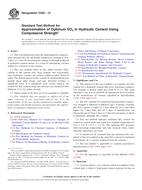Potřebujeme váš souhlas k využití jednotlivých dat, aby se vám mimo jiné mohly ukazovat informace týkající se vašich zájmů. Souhlas udělíte kliknutím na tlačítko „OK“.
ASTM C563-13
Standard Test Method for Approximation of Optimum SO3 in Hydraulic Cement Using Compressive Strength
Automaticky přeložený název:
Standardní zkušební metoda pro aproximaci optimální SO3 v hydraulický cement Použití pevnost v tlaku
NORMA vydána dne 1.1.2013
Informace o normě:
Označení normy: ASTM C563-13
Poznámka: NEPLATNÁ
Datum vydání normy: 1.1.2013
Kód zboží: NS-14030
Počet stran: 4
Přibližná hmotnost: 12 g (0.03 liber)
Země: Americká technická norma
Kategorie: Technické normy ASTM
Anotace textu normy ASTM C563-13 :
Keywords:
blended hydraulic cement, calcium sulfate, cement, compressive strength, gypsum, hydraulic cement, optimum sulfate content (of cement), portland cement, strength (of cement), sulfate content (of cement), ICS Number Code 91.100.10 (Cement. Gypsum. Lime. Mortar)
Doplňující informace
| Significance and Use | ||||||||||||||||||||
|
3.1 The purpose of this test method is to estimate the SO3 content for a hydraulic cement that gives maximum compressive strength in mortar made and cured at 23 °C. The value obtained is one way to establish an appropriate level of sulfate in the manufacture of cements specified in Specifications C150, C595 and C1157. 3.2 The SO3 content of a cement giving maximum compressive strength is different at different ages of mortar; typically this SO3 content is higher at 3 days than the 24-h, and often higher for 7 days than that for 3 days. A manufacturer can choose the age of 24-h, 3 days or 7 days for specimens at which to determine optimum SO3 content. 3.3 This test method indicates optimum SO3.4 It should not be assumed that the optimum SO 3.5 The test method is applicable to cements specified in Specifications C150, C595, and C1157. |
||||||||||||||||||||
| 1. Scope | ||||||||||||||||||||
|
1.1 This test method describes the determination of approximate optimum SO3 for maximum compressive strength at 24 h, 3 days, or 7 days by measuring the change in strength produced in hydraulic cement mortar as a result of substituting calcium sulfate for a portion of the cement. 1.2 This test method refers to the sulfur trioxide (SO3) content of the cement only. Slag cements and occasionally other hydraulic cements can contain sulfide or other forms of sulfur. The determination of SO1.3 Values stated as SI units are to be regarded as standard. 1.4 This standard does not purport to address all of the safety concerns, if any, associated with its use. It is the responsibility of the user of this standard to establish appropriate safety and health practices and determine the applicability of regulatory limitations prior to use. |
||||||||||||||||||||
| 2. Referenced Documents | ||||||||||||||||||||
|
Odebírejte informace o nově vydaných normách ZDARMA:
Chcete pravidelně odebírat informace o nově vycházejících normách z celého světa a to zcela zdarma?
Přihlašte se k odběru. Vše je velice jednoduché a absolutně ZDARMA.
Na výběr máte vydavatele z celého světa.




 Cookies
Cookies
